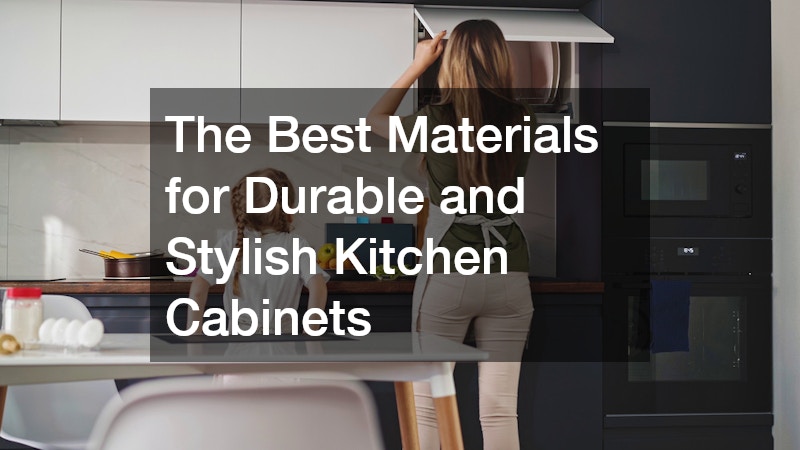When designing or renovating a kitchen, kitchen cabinets play a major role in both functionality and appearance. They are used daily and make up a large portion of the visual space, so it’s important to choose materials that offer both durability and aesthetic appeal. With so many options available, selecting the right cabinet material can be overwhelming, especially when balancing style with practicality.
Understanding the pros and cons of popular cabinet materials will help you make informed choices that suit your lifestyle, design preferences and budget. The right cabinets can transform your kitchen into a space that not only looks beautiful but also stands up to daily wear and tear.
Solid Timber: Classic and Long-Lasting
Solid timber has long been a favourite for kitchen cabinetry in Australian homes. Known for its strength and natural grain, it brings warmth and character to any kitchen style, from coastal cottages to modern farmhouses. Timber cabinets are highly durable and can be sanded, stained or painted over time, giving homeowners the flexibility to refresh their look without replacing the entire structure.
Popular timber types include oak, ash, blackbutt and Tasmanian oak. These hardwoods are resilient and less prone to warping or denting, making them ideal for busy family kitchens. Although timber tends to be more expensive than other materials, it offers a timeless look and the kind of quality that can last for decades when properly cared for.
Moisture resistance is a key consideration, so timber cabinets should be sealed and maintained to avoid swelling or cracking in humid environments. If budget permits, timber is a worthwhile investment that combines craftsmanship with a high-end finish.
MDF and Thermo-Laminated Options
Medium Density Fibreboard, or MDF, is one of the most common materials used in contemporary kitchen cabinets. It’s an engineered wood product made from compressed wood fibres and resin, resulting in a smooth surface that’s ideal for painted finishes or vinyl wraps.
MDF is a cost-effective alternative to solid timber and offers good resistance to cracking or splitting. Thermo-laminated doors, also known as vinyl wrap doors, are often applied to MDF panels and come in a wide range of colours, sheens and textures. They are easy to clean and give a sleek, uniform appearance that suits modern and minimalist kitchens.
While MDF is not as water-resistant as some other options, proper sealing and installation can help prevent swelling or damage. It’s best used in dry areas or above-bench storage where direct moisture exposure is limited.
This material remains a top pick for homeowners who want the look of painted or smooth cabinetry without the price tag of natural wood.
Plywood: Strong and Sustainable
Plywood is another popular choice for kitchen cabinets, especially in homes aiming for a natural or industrial design. It’s made by layering thin sheets of wood veneer with the grain running in opposite directions, creating a strong and stable core that resists warping.
Many Australian renovators choose plywood for its combination of strength, durability and eco-friendly appeal. It holds screws and fasteners well and is less likely to sag over time compared to particleboard or MDF. It’s also more resistant to moisture, making it suitable for areas near sinks or dishwashers.
Plywood cabinets can be left with an exposed edge for a raw, minimalist look or finished with a veneer or laminate for a more polished style. Its versatility has made it a favourite among architects and interior designers alike.
If sustainability is a priority, look for plywood certified by environmental standards like FSC or PEFC, which ensures responsible forest management practices.
Laminate and Melamine: Durable and Budget-Friendly
For homeowners looking to blend durability with affordability, laminate and melamine offer excellent value. These materials are made by bonding decorative paper to a core substrate, usually MDF or particleboard, under high heat and pressure.
Melamine-faced cabinets are widely used in Australian kitchens thanks to their resistance to scratches, stains and moisture. They come in a vast array of colours and finishes, including matte, gloss and woodgrain textures. Laminate is similar but tends to be thicker and more durable, making it suitable for high-traffic kitchens.
Both options are easy to clean and maintain, making them ideal for families or anyone wanting low-maintenance cabinetry. While they may not offer the natural warmth of timber or plywood, advances in print technology have created convincing imitations of wood and stone.
Choosing melamine or laminate cabinets doesn’t mean compromising on style. With the right colour palette and hardware, these materials can look as sleek and sophisticated as more expensive alternatives.
Selecting the right material for your kitchen cabinets is about finding a balance between form and function. Whether you opt for the natural beauty of solid timber, the versatility of MDF or the toughness of laminate, each option offers distinct benefits depending on your needs and budget.
Well-chosen cabinets do more than just store your cookware. They define the look and feel of your kitchen, contribute to its daily usability and add long-term value to your home. By focusing on quality materials suited to your environment and lifestyle, you can create a kitchen that’s both beautiful and built to last.
No matter your renovation goals, thoughtful planning and informed choices will ensure your kitchen cabinets serve you well for years to come.

